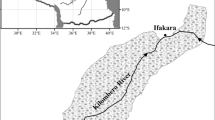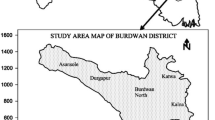Abstract
Floodplain habitat provides important migration and breeding habitat for birds in the midwestern United States. However, few studies have examined how the avian assemblage changes with different stages of floodplain forest succession in the midwestern United States. In spring and summer from 2002 to 2004, we conducted 839 point counts in wet prairie/forbs fields, 547 point counts in early successional forests, and 434 point counts in mature forests to describe the migrating and breeding bird assemblage in the lower Missouri River floodplain. We recorded 131, 121, and 141 species in the three respective habitats, a number higher than most locations in the midwestern United States and comprising > 15% of all avian species in North America. Avian species diversity generally increased from west to east along the river, differed among land cover classes, but overlapped between seasons (migration and breeding) and years. Wet prairies were particularly important for conservation as there were 20 species of high conservation concern observed, including Dickcissels (Spiza americana). Important species for monitoring biotic integrity included the Northern Harrier (Circus cyaneus) and Bobolink (Dolichonyx oryzivorus) in wet prairie, Bell’s Vireo (Vireo bellii) in early successional forest, and Northern Parula (Parula americana) and Prothonotary Warbler (Protonotaria citrea) in mature forest.
Similar content being viewed by others
Literature Cited
Best, L. B., K. E. Freemark, B. S. Steiner, and T. M. Bergin. 1996. Life history and status classifications of birds breeding in Iowa. Journal of the Iowa Academy of Science 103: 34–45.
Boulinier, T., J. D. Nichols, J. R. Sauer, J. E. Hines, and K. H. Pollock. 1998. Estimating species richness to make inference in community ecology: the importance of heterogeneity in species detectability as shown from capture-recapture analyses of North American Breeding Bird Survey Data. Ecology 79: 1018–28.
Brown, B. T. 1993. Bell’s Vireo. In A. Poole, P. Stettenheim, and F. Gill (eds.) The Birds of North America, No. 35. The Academy of Natural Sciences, Philadelphia, PA, USA.
Burnham, K. P. and D. R. Anderson. 2002. Model Selection and Multimodel Inference: a Practical Information-Theoretic Approach. Second edition. Springer-Verlag, New York, NY, USA.
Chapman, D. C., E. A. Ehrhardt, J. F. Fairchild, R. B. Jacobson, B. C. Poulton, L. C. Sappington, B. P. Kelly, and W. R. Mabee. 2004. Ecological dynamics of wetlands at Lisbon Bottom, Big Muddy National Fish and Wildlife Refuge, Missouri. U.S. Geological Survey, Open File Report 2004-1036.
Clarke, K. R. 1993. Non-parametric multivariate analyses of changes in community structure. Australian Journal of Ecology 18: 117–43.
Clarke, K. R. and R. N. Gorley. 2001. PRIMER v5: Users Manual/Tutorial. PRIMER-E Ltd, Plymouth, UK.
Clarke, K. R. and R. M. Warwick. 2001. Change in Marine Communities: An Approach to Statistical Analysis and Interpretation, Second edition. PRIMER-E Ltd, Plymouth, UK.
Dufréne, M. and P. Legendre. 1997. Species assemblages and indicator species: the need for a flexible asymmetrical approach. Ecological Monograph 67: 345–66.
Herkert, J. R., D. W. Sample, and R. E. Warner. 1996. Management of midwestern grassland landscapes for the conservation of migratory birds. p. 89–116. In F. R. Thompson III (ed.) Management of Midwestern Landscapes for the Conservation of neotropical migratory Birds. USDA Forest Service Gen. Tech. Rep. NC-187. USDA Forest Service North Central Forest Experiment Station, St. Paul, MN, USA.
Knutson, M. G., J. P. Hoover, and E. E. Klaas. 1996. The importance of floodplain forests in the conservation and management of neotropical migratory birds in the Midwest. p. 168–88. In F. R. Thompson III (ed.) Management of Midwestern Landscapes for the Conservation of Neotropical Migratory Birds. General Technical Report NC-187. U.S. Forest Service, North Central Forest Experiment Station, St. Paul, MN, USA.
Knutson, M. G. and E. E. Klaas. 1998. Floodplain forest loss and changes in forest community composition and structure in the Upper Mississippi River: a wildlife habitat at risk. Natural Areas Journal 18: 138–50.
Knutson, M. G., L. E. McColl, and S. A. Timm. 2005. Breeding bird assemblages associated with stages of forest succession in large river floodplains. Natural Areas Journal 25: 55–70.
Legendre, P. and L. Legendre. 1998. Numerical Ecology. Second English edition. Elsevier Science BV, Amsterdam, Netherlands.
Linz, G. M., R. A. Dolbeer, J. J. Hanzel, and L. E. Huffman. 1993. Controlling blackbird damage to sunflower and grain crops in the Northern Great Plains. U.S. Department of Agriculture, Agriculture Information Bulletin 679, Washington, DC, USA.
Magurran, A. E. 2003. Ecological Diversity and its Measurement. Princeton University Press, Princeton, NJ, USA.
McCoy, T. D., M. R. Ryan, E. W. Kurzejeski, and L. W. Burger, Jr. 1999. Conservation reserve program: source or sink habitat for grassland birds in Missouri? Journal of Wildlife Management 63: 530–38.
McCune, B. and M. J. Mefford. 1999. PC-ORD. Multivariate Analysis of Ecological Data. Version 4.0 for Windows. MjM Software Design, Gleneden Beach, OR, USA.
McCune, B., J. B. Grace, and D. L. McCune. 2002. Analysis of Ecological Communities. MjM Software Design, Gleneden Beach, OR, USA.
National Ecological Assessment Team. 2006. Strategic Habitat Conservation handbook: a report from the National Ecological Assessent Team — 29 June 2006. U.S. Fish and Wildlife Service, Arlington, VA, USA, and U.S. Geological Survey, Reston, VA, USA.
Petit, L. J. 1999. Prothonotary Warbler (Protonotaria citrea). In A. Poole and F. Gill (eds.) The Birds of North America, No. 408. The Birds of North America, Inc., Philadelphia, PA, USA.
Pianka, E. R. 1966. Latitudinal gradients in species diversity: a review of concepts. American Naturalist 100: 33–46.
Pullin, A. S. and T. M. Knight. 2003. Support for decision making in conservation practice: an evidence-based approach. Journal of Nature Conservation 11: 83–90.
Ralph, C. J., G. R. Geupel, P. Pyle, T. E. Martin, and D. F. DeSante. 1993. Handbook of Field Methods for Monitoring Landbirds. United States Department of Agriculture General Technical Report PSW-GTR-144.
Sauer, J. R., J. E. Hines, and J. Fallon. 2005. The North American Breeding Bird Survey, Results and Analysis 1966–2004. Version 2005.2. United States Geological Survey Patuxent Wildlife Research Center, Laurel, MD, USA. URL: <http://www.mbr-pwrc.usgs.gov/cgi-bin/atlasa99.pl?06040&1&04> (accessed 3 June 2005).
Skinner, R. M., T. S. Baskett, and M. D. Blenden. 1984. Bird habitat on Missouri prairies. Terrestrial Series #14. Missouri Department of Conservation, Jefferson City, MO, USA.
Sutherland, W. J., A. S. Pullin, P. M. Dolman, and T. M. Knight. 2004. The need for evidence-based conservation. Trends in Ecology and Evolution 19: 305–08.
Thogmartin, W. E., M. Gallagher, N. Young, J. J. Rohweder, and M. G. Knutson. 2009. Factors associated with succession of abandoned agricultural lands along the lower Missouri River. Restoration Ecology, 17: 290–96.
Thogmartin, W. E., B. R. Gray, M. Gallagher, N. Young, J. J. Rohweder, and M. G. Knutson. 2007. Power to detect trend in short-term time series of bird abundance. Condor 109: 943–948.
Thogmartin, W. E., M. G. Knutson, J. J. Rohweder, and B. R. Gray. 2005. Bird habitat associations in the lower Missouri River floodplain: a final report to the U.S. Fish and Wildlife Service Big Muddy National Wildlife and Fish Refuge. United States Geological Survey Upper Midwest Environmental Sciences Center, La Crosse, WI, USA.
Thompson III, F. R., S. J. Lewis, J. Green, and D. Ewert. 1993. Status of Neotropical migrant landbirds in the Midwest: Identifying species of management concern. p. 145–158. In D. M. Finch and P. W. Stangel (eds.) Status and Management of Neotropical Migratory Birds. U.S. Department of Agriculture, Forest Service General Technical Report RM-229.
Tramer, E. J. 1974. On latitudinal gradients in avian diversity. Condor 76: 123–30.
Twedt, D. J. and J. Portwood. 1997. Bottomland hardwood reforestation for neotropical migratory birds: are we missing the forest for the trees? Wildlife Society Bulletin 25: 647–52.
Twedt, D. J., R. R. Wilson, J. L. Henne-Kerr, and R. B. Hamilton. 1999. Impact of forest type and management strategy on avian densities in the Mississippi Alluvial Valley, USA. Forest Ecology and Management 123: 261–74.
U.S. Army Corps of Engineers. Missouri River bank stabilization and navigation project, fish and wildlife mitigation project, annual implementation report. United States Army Corps of Engineers, Omaha District, Omaha, Nebraska, and Kansas City District, Kansas City, MO, USA. URL: <http://www. nwd.usace.army.mil> (accessed Sept. 13, 2005).
U.S. Fish and Wildlife Service. 1999. Big Muddy National Fish and Wildlife Refuge Final Environmental Impacts Statement, Puxico, MO, USA.
Winter, M. and J. Faaborg. 1999. Patterns of area sensitivity in grassland-nesting birds. Conservation Biology 13: 1424–36.
Young, N. B., M. A. Gallagher, and S. G. Papon. 2004. Distribution and abundance of migrant and breeding songbirds in floodplain habitats of the lower Missouri River watershed — 2003 Annual Report. U.S. Fish and Wildlife Service Big Muddy National Fish and Wildlife Refuge, Columbia, MO, USA.
Zimmerman, J. L. and J. L. Tatschel. 1975. Floodplain birds of Weston Bend, Missouri River. Wilson Bulletin 87: 196–206.
Author information
Authors and Affiliations
Corresponding author
Rights and permissions
About this article
Cite this article
Thogmartin, W.E., Gallagher, M., Young, N. et al. Avian assemblages in the lower Missouri River floodplain. Wetlands 29, 552–562 (2009). https://doi.org/10.1672/08-65.1
Received:
Accepted:
Issue Date:
DOI: https://doi.org/10.1672/08-65.1




